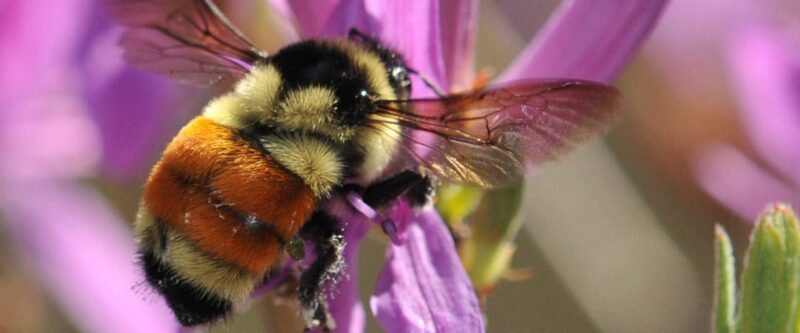Until this year, June was arguably my favorite month – with its luxuriously long days, beach time, succulent strawberries and delectable snap peas.
But this June brought trench warfare, forcing me to combat squadrons of ravenous mosquitoes and black flies along with midges undeterred by mere window screens. Ticks lay in ambush and browntail moth caterpillar hairs hit exposed skin like shrapnel. (Ticks, which are technically arachnids not insects, provoke particular anxiety due to their time-bomb bites and their potential to transmit multifarious diseases.)
The first half of summer I spent scratching, rarely even knowing which aggressor had inflicted the latest irritation. I came to understand as never before the etymological root of insect, the Latin verb insecare, “to cut into.”
Scientists estimate that for every human on Earth, there are more than 200 million insects. At times this June, it seemed to me that they were all in close proximity.
So when I heard of the new book “Buzz, Sting, Bite: Why We Need Insects,” I knew I should read it – if only to sweeten my sour attitude. Anne Sverdrup-Thygeson’s witty take on what she calls “six-legged lifesavers” was the perfect salve, helping me repair relations with my small neighbors.
Sverdrup-Thygeson, a conservation biologist at the Norwegian University of Life Sciences, must have known that some of her readers – beleaguered by certain bugs – might be asking exactly why creatures like mosquitoes are necessary. Humans often view insects through a utilitarian lens, being – in her words – “quick to categorize other species (as a) help or hindrance to us.”
Even as she challenges that ethical premise, Sverdrup-Thygeson affirms the many valuable functions that insects play in natural ecosystems. Her profiles of various species, reminiscent of the children’s book “Insects Do the Strangest Things,” demonstrate how these specialized and sometimes bizarre creatures feed fish, birds and bats; disperse seeds; pollinate plants; provide free waste disposal; build soil and even – in some cases – nurture and teach each other (despite often having, in her words, “a brain no bigger than the ‘o’ in this sentence.”)
The book’s anecdotes and offbeat humor build sympathy even for insects often seen as irritants. I can better tolerate having a deerfly or two land in my hair after learning that one Norwegian elk examined by researchers had 10,000 of them. And earwigs become slightly more tolerable after learning they are “particularly affectionate mothers.”
A midge not so different from the biting variety in Maine turns out, in Sverdrup-Thygeson’s words, to be “almost single-handedly responsible” for the pollination of cacao flowers and hence aids in the production of chocolate. That is justification enough for a better attitude toward all midges!
Insects may be spineless, she notes, but they have a formidable set of skills. Dung beetles, for example, can navigate using the Milky Way, while other beetles employ artistry in their self-defense. The leaf beetle larva, for example, gets quite creative with its excrement, Sverdrup-Thygeson observes, chomping on palm leaves until “beautiful pale yellow curly threads ooze out at the opposite end. The larva arranges these pale threads of dung neatly over its back until it ends up with a whole wig.”
Six-legged creatures deserve respect, she argues, not only for their ingenuity but for their endurance on an evolutionary scale. “Insects saw the dinosaurs come and go, by a long margin,” she writes, and they took to flight before any other type of animal did, having “global dominance of the air for more than 150 million years.”
Their long tenure on earth has given many insect species the chance to evolve in ways that refine their efficiency in hunting and gathering. Whereas lions are successful in hunting missions about a quarter of the time and great white sharks about half the time, Sverdrup-Thygeson writes, dragonflies – with their four wings – typically get their prey 95 percent of the time. Their wing structure helped inspire the design of drones.
The skills and contributions of insects often go unrecognized by humans who know little about the inner workings of complex ecosystems. Sverdrup-Thygeson cites an example from Australia in which scientists were surprised to find that wheat fields not treated with insecticide had 36 percent higher harvest rates, greater water retention and much more nitrogen.
In the unsprayed fields, insects actually improved growing conditions. Earthworms helped aerate the soil and retain moisture, the intestinal bacteria in termites helped capture nitrogen from the air, and seed-eating ants helped control weeds, resulting in half as many weeds as in the sprayed fields.
Humans often unwittingly harm insects that provide vital but unacknowledged services in the natural community. Sverdrup-Thygeson describes how the widely used antiparasitic ivermectin harms the dung beetles that help break down bovine waste. Now globally, 15 percent of those beetles vital to waste management and soil-building are threatened.
Despite her playful tone and welcome humor, Sverdrup-Thygeson reminds readers that our species has a serious “moral duty to coexist” with our insect neighbors. The tiny fraction of insects that can irritate us should not blind us to the gifts of the trillions of them that keep our world livable. As Sverdrup-Thygeson recently told NPR’s Terry Gross, “they are actually saving your life a little every single day.”
That will be my new bug mantra, even as I reach for the anti-itch cream.




